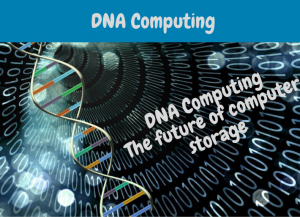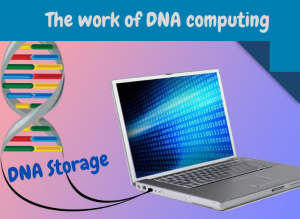DNA computing
What is DNA Computing?
DNA computing is a modern area of science that recognizes biomolecules as fundamental elements of electronic devices. This is related to several other areas including chemistry, software engineering, cell genetics, physics, and mathematics. Computing with biological molecules, rather than conventional silicon chips. While its conceptual history stretches back to the early 1950s, the principle of computing with molecules was only understood scientifically in 1994, when Leonard Adleman illustrated the answer of a small aspect of a very well-known problem in combinatorics utilizing standard molecular biology methods in the lab. Since this study, curiosity in DNA computing has significantly increased, and now it’s a best-established research field. Leonard Adleman demonstrated how a statistical problem can be solved with molecules.

Figure 1. DNA Computing
How will the computer with DNA work?
Scientists have discovered a new material to create the next generation of computer chips they require. Hundreds of thousands of natural powerful computers, like your body, reside within living things. DNA (deoxyribonucleic acid) molecules, the component from which our genes are produced, can generate data several times greater than the most efficient human-built computing devices … The reason for this enthusiasm was that DNA molecules are inexpensive, fairly simple to manufacture, and versatile. There’s no limitation to the capacity that DNA computation can potentially have as power is increased more and more compounds you add to the equation but unlike silicon transistors that can conduct a single rational item at a time, these DNA structures can potentially conduct as much of the operations at a time as possible to resolve an issue and do everything all at once …… For a long period of time scientists have been aware that DNA could be used to store data. Compared to standard devices DNA computers take a radically different approach to fixing the issues. “Modern electronic processors have to choose a route to follow when they come to a T-junction, while a DNA computer doesn’t have to decide because it reproduces itself through follow both directions at the same moment. Complex mathematical problems have been already solved with DNA molecules. Though still in its development, DNA computers will be able to hold billions of times greater data than your personal computer. The researchers use genetic material to create nano-computers that could take the place of machines based on silicon over the next decade.

Figure 2. The work of DNA Computing
The experiments and Success of DNA Computers.
Scientists have created a new form of DNA device that operates in living organisms, potentially opening the way for a separate system that can pick out infected cells from some very healthy cells. The machine operates on a mechanism called RNA interference (RNAi), one where small RNA molecules inhibit the development of protein by a gene. The Adleman DNA computer ‘s achievement is evidence that DNA could be used to analyse complex math equations. This initial DNA machine is very far from intimidating computers built on silicone in terms of efficiency, nevertheless. Computer scientists at Davis and Caltech University of California have formulated DNA molecules that can be self-assembled into frameworks by using six-bit inputs to effectively run their own programme. Microsoft also has a programming language for DNA computing which will help make DNA computing functional once bio-processor technology is progressing to the stage that it can operate more sophisticated algorithms. In addition, Microsoft plans to incorporate DNA computing into its cloud services by 2020, and to aggressively build DNA storage space to incorporate into its cloud computing. The Adleman DNA machine very easily produced a collection of potential responses, but it required Adleman days to limit down the options. The objective of the area of DNA computing is to establish a system that can operate independently of human intervention. It will take several years for the DNA computer components to evolve logic gates and biochips into a functional, feasible DNA device. Scientists believe that if such a computer is ever designed it would be more lightweight, reliable and powerful than today’s computers.
Advantages of DNA based Computer.
The process starts with the use of DNA by allocating DNA strands to cities on a chart and to linkages among cities. The city strands are to link with the interactions and shape strands consisting of paths via the various cities. The strands are then arranged in such a way that only the proper number of cities are related. Carry out hundreds of thousands of tasks at the same time. DNA computers’ massively parallel computational power can give them the ability to seek solvable approaches to otherwise difficult issues, and possibly speed up massive, but otherwise possible to solve, polynomial-time problems commonly used to increase few procedures. There is “still the risk that a few of the strands would include the same city twice,” so the DNA is carried through filtration; each filter collects only DNA comprising a certain segment (each section representing a region). A further advantage of this method to DNA is that it operates in “parallel,” concurrently analysing all potential scenarios. It thus enables large parallel investigations to be conducted and a full set of possible solutions to be produced. DNA can contain more information than a trillion CDs in a cubic centimetre, thereby allowing it to accommodate vast quantities of working memory adequately. The DNA machine also has very low power consumption, and if it is mounted within the cell this would not need much energy to work and its energy-efficiency is much more than a thousand times that of a PC. While still in its infancy, machines with DNA are able to store billions of times more data than a personal computer. The DNA strands that the filters survive reflect all alternative avenues through the cities.
The future of DNA computing.
The interaction of chemists, biologists, mathematicians and software engineers to recognize and model essential biological processes and algorithms occurring inside cells makes DNA computing so fascinating. CONVENTIONAL machines perform linear calculations (that is, assume tasks one at a time). Nevertheless, parallel DNA computational power could tackle math problems in hours which would take many years for electronic computers. The DNA machine is in the very initial phases of development, however, there are actually many areas in active usage (or underactive technologies). Technically, classical DNA computing techniques have already been applied in real-life problems: breaking the Data Encryption Standard, DES. While this task has already been resolved using traditional techniques in a far shorter time than proposed by DNA methods, the DNA models are far more versatile, efficient, and cost-effective. A machine composed of DNA and enzymes was developed by Israeli researchers.